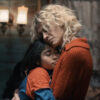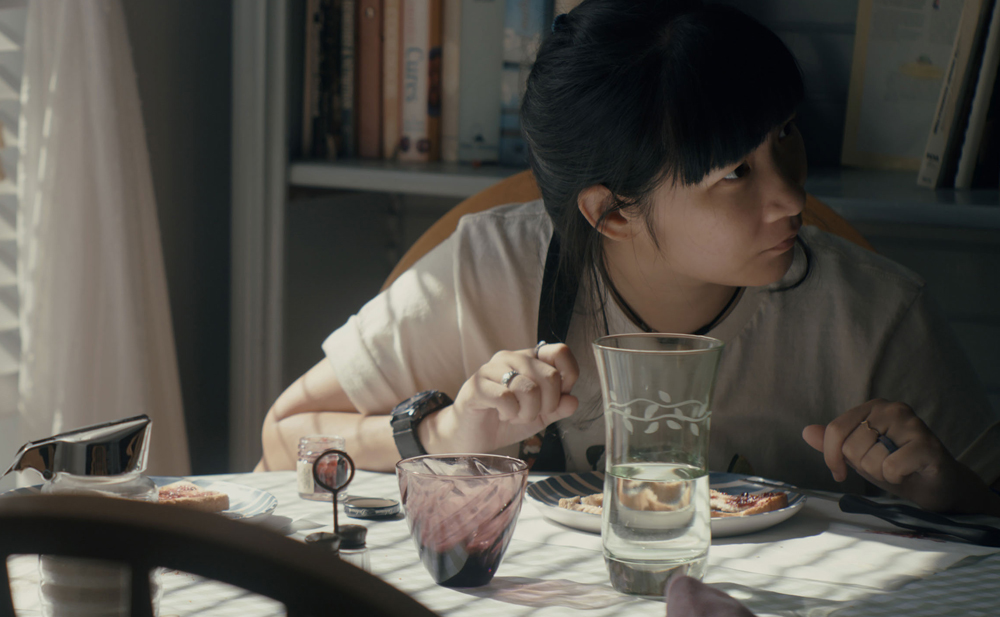A flag is planted in the opening seconds of “Take Me Home,” with a small Old Glory placed on the lawn of the home Anna (Anna Sargent) shares with her mother (Joan Sargent), but the young woman with special needs is asserting herself in other ways around the house. Making soup for herself may be a challenge, but she’s intent on fending for herself, something she clearly wants but may also become a necessity when it appears her mother is at death’s door and her sister Emily (Jeena Yi) has built a life of her own across the country in New York. In Liz Sargent’s heartrending drama, that transition happens quicker than anyone could’ve hoped.
However, the fact that the Campbell’s Chicken and Rice makes it out hot and ready to eat, albeit not in the can that Anna unwisely placed in the microwave at first, portends the fact that things are likely going to be okay in spite of some bumps in the road in “Take Me Home,” where Sargent tenderly looks at the thorny process of Emily assuming guardianship for Anna while honoring her desire to be her own person. The short packs plenty into its 15 minutes where Emily flies in to start filling out the paperwork necessary to take care of Anna, with frustrations mounting as soon as she arrives when she has no idea how much medication her sister is supposed to be taking and doesn’t have the power of attorney to find out from her doctors. But then there is the emotionally fraught process of reuniting with Anna where the two barely have the time to share in the grief of losing a mother given all the arrangements that need to be made and Emily faces the additional burden of negotiating independence for Anna while providing the support that she needs.
By seeing the last names of most of the cast, you might suspect “Take Me Home” is much more than a film for Sargent, who enlists both her real sister and mother to star in the film and the authenticity they bring makes all the difference in this touching slice of life that’s set to premiere this week at the Sundance Film Festival. On the eve of its big debut in Park City, Sargent spoke about how she seamlessly blended her personal and professional lives into the project, bringing Anna’s perspective to the screen and how a background in dance led to her making such moving pictures.
How did this come about?
I’ve been thinking about this film for forever. It’s so personal to me. My parents had four kids and they adopted seven, six [of whom] are Korean. I’m the middle child, and this story is about my youngest sister who has an intellectual disability. I’ve always been thinking about this transition point in our lives where my parents will pass away, and what is the responsibility of her family, and how do we weigh independence? I’ve only just married my life responsibilities with my art and recently, my sister and I have been going through the process to become guardians for her, so we’re learning about all the impossible loopholes with HIPAA and what services are available to people with disabilities, with mental illness and for aging. I think about that across America, and to me, this little story is a bigger comment on how we treat the people who can’t care for themselves anymore in this country.
It’s also a beautiful merging of art and life in its fabric when your sister Anna is the lead. Was she in mind from the start to actually act in it?
Yeah, my sister was always the inspiration for this. Obviously, it was written in her voice, deeply in her point of view [with] things I’ve heard her say and her speech patterns, and deeply in her point of view, so it only made sense to cast her because I think that we see the story within the way that she holds her body, the rhythm in her speech and we wanted to give her the freedom to perform that. Some people make this comment, like you were saying that it’s this mixture of narrative and documentary or something in between, and that happened on set because Jeena Yi the actress who played her sister, did these scenes on repetition. There’s so many talented, skilled people in the film industry, but we were like, the energy in the room is so important and we need good people.
Jeena has a strong theater background,and because I knew she could do the repetitions and she was deeply invested in process, it was incredible. In [some] ways, I say that she had to be the second director in the room – she had to go with what was ever happening, and help lead it all. Anna’s a very loving person, so she fell in love with Jeena immediately, and Jeena’s just such a good, generous person and open to the process, they had a really great relationship and because Anna has very little short-term memory, we often had to prompt a line to her, but after the repetition’s built, she would create the scenario in her head and do a little improvisation off of it and it would often be just more perfect and condensed and honest than I could even imagine, so she brought a lot to it and we always knew she would.
Was there anything unanticipated that you could get really excited about?
There’s one scene, a little monologue she has in there that’s totally her own doing. We set that up almost like an open improvisation where the social worker in the scene was just supposed to ask certain questions within the room, and it was more [about] a physical blocking of the scene, and Anna standing in the middle, reacting to them. But Anna created that monologue totally on her own and I love that that’s a long take where we stay with her, and we see the way that her mind processes things.
Was this a space you and Anna were familiar with?
It was in my parents’ home, but we rearranged and gutted a lot of things. [Anna’s] has a long, personal history with some of the props, so I knew immediately if they were moved or changed what her reaction would be and every piece of it was where we choose reality and within it. The sunglasses are her obsessive collection, which was written into the script, so we didn’t have to go find that [as a prop]. What’s interesting is I met someone who has a sibling with a disability, and there’s just that tiny moment where Anna hands over a bracelet to Jeena [as] her sister, and in the edit, I felt like, “Oh, I think that’s a little too quick. People aren’t really going to process what a big deal it is for her to share, and to see somebody else’s struggle in that way.” The woman who has a sibling saw the film and was so emotionally moved by it because she knew that that is exactly how her sibling processes and shares, and what a big deal that would be, so it’s beautiful to see those tiny details resonate with the audience it’s for.
Could you actually involve Anna in the conception of this at all?
Because Anna has trouble articulating herself, and she has very little short-term memory, it’s a lot of me processing her perspective. But I’m so close to her, I was always trying to be very sensitive to what that is to empower her. The story was actually built in a different way [initially], but I started seeing the flaws in it where the sister from New York was in it more. And I thought, “You know what? This story has been told so many times with the able-bodied sibling having the burden, and it’s not really about the woman with a disability.” So [I thought], “You know what? I want to go deep into that, and only that.” So the sister [became] a supporting character. She’s not important. We want to see how this moment affects Anna.
The score is quite beautiful, which builds from individual guitar strings to a really robust sound. What was that like to work on?
We tried out a lot of different music on the film, and a lot of it just felt too processed or stayed with Anna’s point of view, so I asked the gaffer, who’s a friend of mine who hadn’t picked up his guitar in years, to fiddle around and try to find a song and learn it, but I told him, “Record all of it. I want to hear all the wrong notes, I want to hear your fingers on the strings, I want to hear the thought process of finding the rhythm” because I felt like that was Anna’s voice. That’s how she speaks. When I used this music that was more produced, it felt like it was pulling the audience out of the film in a way. It felt comfortable in a way that felt almost ableist — I was like, “I didn’t know that there could be ableist music.” But definitely, there is. So I love that [score now]. And then for the end piece, I recorded Anna and my mother humming a melody that a friend wrote, and these composers built the song around it and I loved that because, again, it’s Anna’s voice is leading every single moment in this.
I was intrigued to find out that you had a background in dance. Is there any cross-pollination now in the films you make?
Yeah, a lot of people notice that in my work, but it’s so much a part of me that I’m not even sure how it shows up. But the way I wrote my dance work in college was very personal, and the stories that I was thinking about as an adult, [where] I was like, “Oh, these are the real things that I’m struggling with, my family and my responsibility,” felt too big and too intimate to put into dance, which is so esoteric, so I always wanted to get into film. You can see my dance background [still] because I’m really thinking about gesture, and emotional moments, and giving time and space for that, and what’s not said on the screen.
What’s it like starting to get this film out into the world?
It feels like a really exciting and powerful opportunity, because it’s about starting a conversation. We really want to do an educational and a community push, so it reaches the audiences that it’s made for, and that it starts this conversation about future caregiving. We are thinking more deeply about how Anna sees the world and how everybody processes the world differently, and it’s a proof of concept for feature, so building that out is really important to us.
“Take Me Home” will screen at the Sundance Film Festival as part of Short Film Program 6 on January 23rd at 9 pm at Prospector Square Theatre in Park City, January 26th at 2:50 pm at Broadway Centre Cinemas in Salt Lake City, January 28th at 11 am at the Egyptian Theatre in Park City, January 29th at 12:45 pm at the Broadway Centre Cinemas in Salt Lake City.




